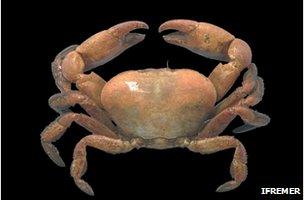'Abyss Box' to keep deep animals
- Published

The Abyss Box will contain deep-sea crab and shrimp - and sustain them over the long term
The public are going to get the chance to see live creatures pulled up from the deep ocean in a permanent display.
Normally when organisms are raised from kilometres below the sea surface, they quickly die because of the huge change in pressure.
But scientists have now developed the Abyss Box, which can maintain animals in the extreme environment they need.
The vessel, containing deep-sea crab and shrimp, will go on show at the Oceanopolis aquarium in Brest, France.
The volume of the box is quite small (16 litres) but researchers believe the technology could eventually be scaled up to house larger animals, such as fish.
It is hoped such vessels will enable scientists to study bottom-dwelling creatures over long periods of time - something that is just not possible at the moment.
"We want such basic information as the length of life of a deep-sea animal," explained Dr Bruce Shillito, a marine biologist at the Universite Pierre et Marie Curie, Paris.
"No-one really knows how long they live, so by keeping them this way we can get that information. Of course, its information in captivity but it's better than no information at all," he told BBC News.
Dr Shillito has been discussing the project here at the annual meeting of the American Association for the Advancement of Science (AAAS).
He famously retrieved a live fish from a record depth of 2,300m at the hot vents on the Mid-Atlantic Ridge.
On that occasion, he used his Periscop vessel, which kept the animal under pressure as it made its journey to the surface.
Bruce Shillito: "No-one really knows how long they live"
But the Abyss Box goes a stage further because it is equipped to sustain and nourish its residents over the long term. This means changing its water regularly, and introducing food while still maintaining a pressure of 18 megapascal (180 bar) - equivalent to a depth of about 1,800m.
Something edible - probably blue mussel - will be put through an exchange chamber. "It's like the astronauts moving in and out of the space station," said Dr Shillito.
Indeed, the pressure inside the box means the public will have quite a restricted view of the shrimp and crab. The window - there is only one - is a porthole 10cm thick and 15cm wide. And the volume inside is just 16 litres. Even so, all the equipment required to maintain the extreme environment means the Abyss Box weighs 600kg.
Scientists will use this kind of technology to understand how organisms survive at depth and what their lifecycles are like.
There is an acknowledgement that warmer seas are forcing some creatures to go deeper to stay in the coolers waters they prefer.
Not every marine organism has this ability to migrate downwards, however, and equipment like the Abyss Box will be used to run experiments to establish which creatures are likely to make the move successfully.
"It is well established knowledge that climate warming is causing changes in the distribution or organisms at the global scale," said Dr Sven Thatje, a colleague of Dr Shillito's from the University of Southampton, UK.
"Many species inhabiting the oceans have already gone cooler by moving to higher latitudes where they have not been found before.
"We propose that moving to greater depths is an ignored response mechanism that allows species to escape undesirably warm surface waters. Changes in the depth distribution of species will lead to major changes in ocean ecosystems."
Oceanopolis is expected to put the Abyss Box on display in April.
Jonathan.Amos-INTERNET@bbc.co.uk and follow me on Twitter, external